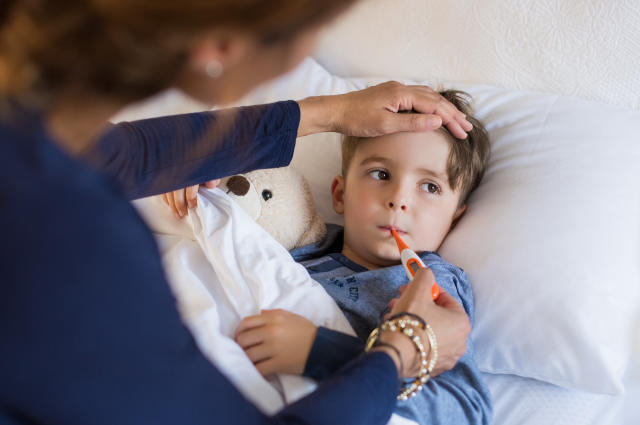School Sick Days: A Parent’s Guide to Ensuring Kids’ Health
The well-being of our children is of paramount importance, and as parents, it’s our duty to provide them with the care and support they need, especially when they’re under the weather. School sick days are an inevitable part of a child’s life, and understanding how to handle these situations is vital to ensure their comfort, recovery, and safety.
Different Conditions and Symptoms:
School sick days can arise due to various health conditions. From common colds to more severe illnesses, being prepared to manage these situations is crucial. Some common scenarios include:
Fever: Elevated Body Temperature and Underlying Infections:
Fever, often accompanied by a rise in body temperature, is the body’s natural response to an infection. It indicates that the immune system is working to fight off an invader, such as a virus or bacteria. Sending a child with a fever to school not only exposes them to additional stress but also poses a risk to other students and staff. High fever can lead to fatigue, irritability, and difficulty concentrating, hindering their ability to participate fully in class activities. Moreover, there’s a possibility that the infection causing the fever is contagious, putting others at risk of contracting the illness. Waiting until the fever subsides without the use of fever-reducing medications ensures that the child is on the mend and less likely to spread the infection to their peers.
Vomiting and Diarrhea: Dehydration and Discomfort:
Gastrointestinal issues such as vomiting and diarrhea can rapidly lead to dehydration, especially in children. Dehydration impairs focus, energy levels, and overall well-being. Sending a child with these symptoms to school not only exposes them to discomfort but also exacerbates their risk of dehydration due to limited access to fluids and bathroom breaks. Additionally, gastrointestinal infections are often contagious, making it crucial to keep the child at home to prevent the potential spread of the illness to classmates and staff. Providing the child with adequate rest, fluids, and time to recover at home ensures their comfort and reduces the risk of infecting others.
Fatigue: Impending Illness and Reduced Participation:
Extreme tiredness or fatigue can be an early sign of an impending illness. When a child is fatigued, their immune system is compromised, making them more susceptible to infections and delaying the body’s healing process. Sending a fatigued child to school not only hinders their ability to fully engage in lessons but also increases their vulnerability to picking up other illnesses in their weakened state. Allowing the child to rest at home helps the body recover more quickly and prevents them from pushing themselves too hard, potentially worsening their condition.
Persistent Cough and Sore Throat: Respiratory Infections and Contagiousness:
A persistent cough and sore throat are often indicative of a respiratory infection, such as the common cold or flu. These symptoms can be uncomfortable and disruptive to the child’s ability to focus in class. Moreover, respiratory infections are often highly contagious, especially in the early stages. Sending a child to school with these symptoms not only negatively impacts their own well-being but also exposes classmates and teachers to potential infection. Keeping the child at home until the symptoms improve not only ensures their recovery but also prevents the spread of illness in the school environment.
Irritated Eyes and Rashes: Allergic Reactions and Infections:
Irritated eyes and rashes can stem from allergic reactions, infections, or other underlying conditions. These symptoms can be uncomfortable and distracting for the child, affecting their ability to participate in class activities and engage with their peers. If the cause is infectious, sending the child to school can put others at risk. In cases of allergies, the child might be triggered by allergens present in the school environment. Allowing the child time to recover and receive appropriate medical attention ensures their comfort and prevents the potential spread of infections or exacerbation of allergic reactions.
Appearance and Attitude: Indicators of Illness and Well-Being:
Noticeable changes in a child’s behavior, appetite, or mood often indicate that they are unwell. A sudden shift in their appearance or attitude might be a result of an ongoing illness or discomfort. Sending a child in this condition to school not only hinders their ability to concentrate and engage but also potentially exposes them to further stressors that could impede their recovery. Providing them with the opportunity to rest, receive medical care if necessary, and regain their well-being is paramount to ensuring their comfort and proper recovery.
Pain: Unexplained Discomfort and Potential Underlying Issues:
Unexplained pain or discomfort should never be ignored, as it could indicate an underlying health issue. Sending a child to school in pain not only affects their ability to focus but could also exacerbate the underlying problem. Ignoring or downplaying pain could lead to complications or prolonged discomfort. It’s essential to seek medical attention to diagnose the source of pain and determine whether the child is fit to attend school. Addressing the issue promptly ensures the child’s well-being and prevents the development of more serious health concerns.
Rest and Hydration: Ensuring Recovery Through Adequate Rest and Fluids:
Rest is a cornerstone of the healing process. When a child is unwell, their body diverts energy towards fighting off infections or addressing underlying issues. Providing ample rest allows the body to allocate resources to recovery, expediting healing processes. Hydration, too, plays a pivotal role. Adequate fluid intake helps maintain bodily functions, prevents dehydration caused by fever, vomiting, or diarrhea, and aids in flushing out toxins. Encouraging your child to drink water, clear soups, and oral rehydration solutions is essential. Adequate rest and hydration together enhance the body’s capacity to rebound from illness.
Consult a Healthcare Professional: Expert Diagnosis and Treatment for Severe Symptoms:
In cases where symptoms are severe or persist, seeking professional medical advice is paramount. A healthcare professional can provide an accurate diagnosis, ruling out serious conditions, and recommend appropriate treatment strategies. Their expertise ensures that the underlying cause of the symptoms is addressed effectively, potentially averting complications. Rather than relying solely on online sources or self-diagnosis, consulting a healthcare professional guarantees personalized care and evidence-based treatment, ensuring your child’s health is in capable hands.
Medication: Prudent Administration of Prescribed Medications:
If your child’s illness requires medication, adhering to the prescribed regimen is crucial. Medications prescribed by a healthcare professional are intended to alleviate specific symptoms, accelerate recovery, or address underlying issues. Adhering to dosage instructions and timing prevents overuse or underuse, both of which can hinder the desired outcome. Administering medications as prescribed by a professional ensures that your child receives the appropriate treatment, minimizing discomfort and reducing the duration of their illness.
Isolation: Preventing Contagion through At-Home Rest:
When a child is unwell, it’s essential to keep them at home to prevent the potential spread of illness to classmates and teachers. Some illnesses are highly contagious during their initial stages, and sending a sick child to school could lead to outbreaks or further infections. Isolating the child at home until their symptoms subside not only safeguards the health of others but also offers the child an environment conducive to rest and recovery without exposing them to additional stressors.
Comfort: Creating a Supportive Environment for Recovery:
Being unwell can be distressing, especially for children. Providing a cozy and comfortable environment at home can significantly contribute to their well-being. A familiar and nurturing atmosphere can alleviate anxiety, enhance their sense of security, and aid in the recovery process. Comforting items like soft blankets, favorite toys, and soothing activities can provide a distraction from discomfort and promote a positive mindset. By fostering a space that prioritizes their comfort, you create the ideal conditions for a smoother and faster recovery process.
Knowing When It’s Safe to Return to School:
Determining when your child is ready to return to school after a sick day involves careful consideration. Some key points to ponder include:
- Fever: Wait until your child is fever-free for at least 24 hours without the use of fever-reducing medication.
- Contagiousness: Ensure symptoms like vomiting, diarrhea, or fever have subsided before returning to school.
- Medical Clearance: In cases of severe illness, consult a doctor before sending your child back to school.
Handling school sick days demands patience, vigilance, and empathy. As parents, we play a pivotal role in our children’s health and well-being. By being informed about different conditions, employing effective management strategies, and making informed decisions about when it’s safe for our children to return to school, we can ensure that their health remains a top priority




